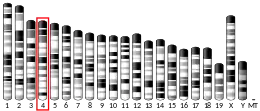Chromodomain-helicase-DNA-binding protein 5 is an enzyme that in humans is encoded by the CHD5 gene.[5][6][7] It is a part of the CHD subfamily of ATP-dependent chromatin remodeling complexes.
References
- 1 2 3 GRCh38: Ensembl release 89: ENSG00000116254 - Ensembl, May 2017
- 1 2 3 GRCm38: Ensembl release 89: ENSMUSG00000005045 - Ensembl, May 2017
- ↑ "Human PubMed Reference:". National Center for Biotechnology Information, U.S. National Library of Medicine.
- ↑ "Mouse PubMed Reference:". National Center for Biotechnology Information, U.S. National Library of Medicine.
- ↑ Schuster EF, Stoger R (Mar 2002). "CHD5 defines a new subfamily of chromodomain-SWI2/SNF2-like helicases". Mamm Genome. 13 (2): 117–9. doi:10.1007/s00335-001-3042-6. PMID 11889561. S2CID 1694959.
- ↑ Thompson PM, Gotoh T, Kok M, White PS, Brodeur GM (Feb 2003). "CHD5, a new member of the chromodomain gene family, is preferentially expressed in the nervous system". Oncogene. 22 (7): 1002–11. doi:10.1038/sj.onc.1206211. PMID 12592387.
- ↑ "Entrez Gene: CHD5 chromodomain helicase DNA binding protein 5".
External links
- Human CHD5 genome location and CHD5 gene details page in the UCSC Genome Browser.
Further reading
- Nakajima D, Okazaki N, Yamakawa H, et al. (2003). "Construction of expression-ready cDNA clones for KIAA genes: manual curation of 330 KIAA cDNA clones". DNA Res. 9 (3): 99–106. doi:10.1093/dnares/9.3.99. PMID 12168954.
{{cite journal}}: CS1 maint: overridden setting (link) - Seki N, Ohira M, Nagase T, et al. (1998). "Characterization of cDNA clones in size-fractionated cDNA libraries from human brain". DNA Res. 4 (5): 345–9. doi:10.1093/dnares/4.5.345. PMID 9455484.
{{cite journal}}: CS1 maint: overridden setting (link) - Nagase T, Kikuno R, Ishikawa KI, et al. (2000). "Prediction of the coding sequences of unidentified human genes. XVI. The complete sequences of 150 new cDNA clones from brain which code for large proteins in vitro". DNA Res. 7 (1): 65–73. doi:10.1093/dnares/7.1.65. PMID 10718198.
{{cite journal}}: CS1 maint: overridden setting (link) - Deloukas P, Matthews LH, Ashurst J, et al. (2002). "The DNA sequence and comparative analysis of human chromosome 20". Nature. 414 (6866): 865–71. Bibcode:2001Natur.414..865D. doi:10.1038/414865a. PMID 11780052.
{{cite journal}}: CS1 maint: overridden setting (link) - Ota T, Suzuki Y, Nishikawa T, et al. (2004). "Complete sequencing and characterization of 21,243 full-length human cDNAs". Nat. Genet. 36 (1): 40–5. doi:10.1038/ng1285. PMID 14702039.
{{cite journal}}: CS1 maint: overridden setting (link) - Gerhard DS, Wagner L, Feingold EA, et al. (2004). "The Status, Quality, and Expansion of the NIH Full-Length cDNA Project: The Mammalian Gene Collection (MGC)". Genome Res. 14 (10B): 2121–7. doi:10.1101/gr.2596504. PMC 528928. PMID 15489334.
{{cite journal}}: CS1 maint: overridden setting (link) - Gregory SG, Barlow KF, McLay KE, et al. (2006). "The DNA sequence and biological annotation of human chromosome 1". Nature. 441 (7091): 315–21. Bibcode:2006Natur.441..315G. doi:10.1038/nature04727. PMID 16710414.
{{cite journal}}: CS1 maint: overridden setting (link) - Olsen JV, Blagoev B, Gnad F, et al. (2006). "Global, in vivo, and site-specific phosphorylation dynamics in signaling networks". Cell. 127 (3): 635–48. doi:10.1016/j.cell.2006.09.026. PMID 17081983. S2CID 7827573.
{{cite journal}}: CS1 maint: overridden setting (link) - Bagchi A, Papazoglu C, Wu Y, et al. (2007). "CHD5 is a tumor suppressor at human 1p36". Cell. 128 (3): 459–75. doi:10.1016/j.cell.2006.11.052. PMID 17289567. S2CID 13437928.
{{cite journal}}: CS1 maint: overridden setting (link)
This article is issued from Wikipedia. The text is licensed under Creative Commons - Attribution - Sharealike. Additional terms may apply for the media files.







